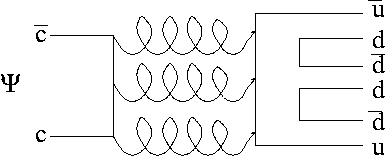So far the OZI rule has been postulated but no dynamical explanation has been provided.
The OZI rule can be rephrased in the language of QCD. The J/Ψ decay into hadrons in QCD mediated by gluon annihilation is depicted in:

The annihilation can also not be mediated by two gluons since vector particles cannot decay into two massless vectors.
As a consequence, the charmonium state J/Ψ must annihilate at least into three gluons. As a consequence, the decay width of the J/Ψ into hadrons is proportional to αs3.
It turns out that the QCD coupling constant αs strongly depends on the energy scale of the process. For the annihilation process under consideration the energy scale is given by mc.
In the next section it is shown that αs(mc)=0.278 +-0.014.
As a consequence, application of perturbation theory makes sense and the decay of the J/Ψ into hadrons is dynamically suppressed due to annihilation into three hard gluons.
REMARK: If the colour singlet gluon existed the decay of the J/Ψ but more importantly also of the Υ into one virtual gluon would be possible which could in term decay into a quark and an anti-quark resulting into hadron jets.
The fact that these hadron jets are not observed in the quarkonia decays is also an argument why colour singlet gluons do not exist in nature.